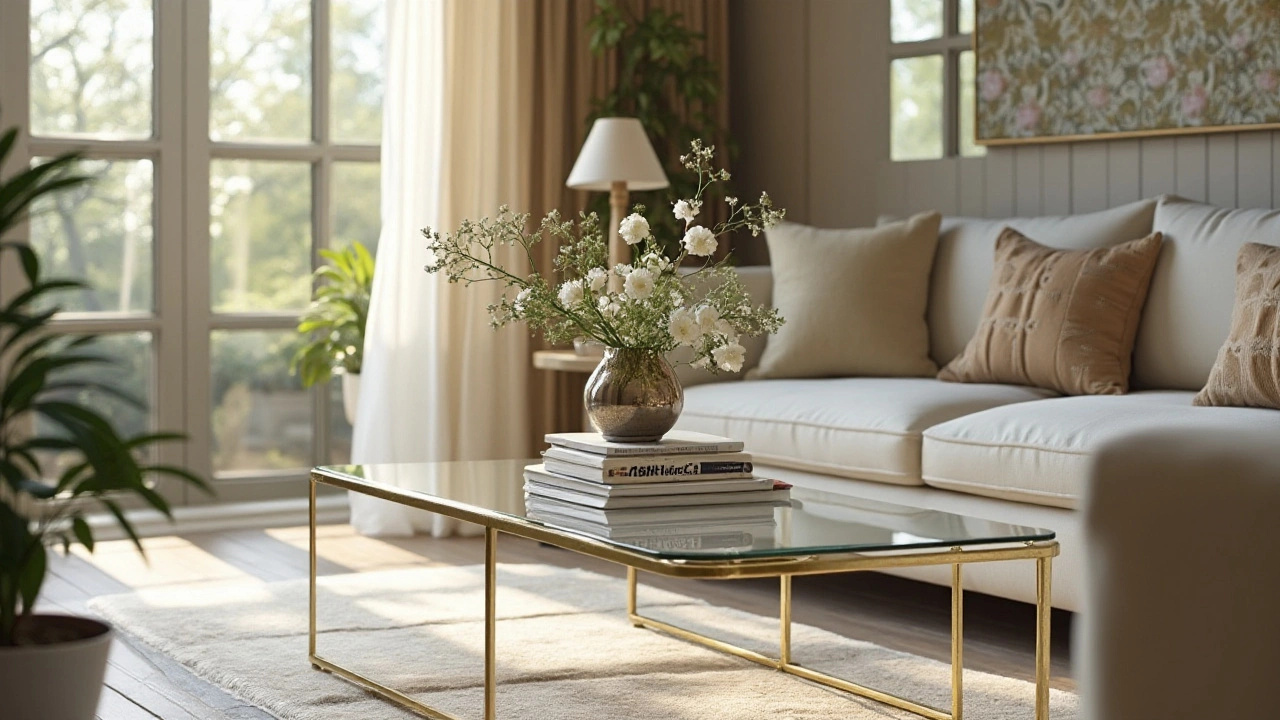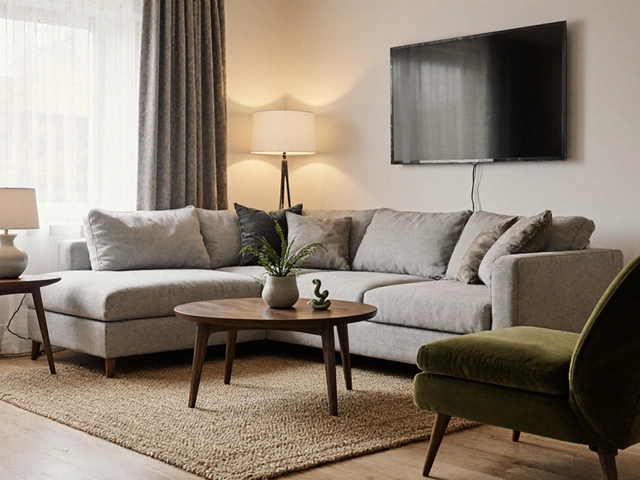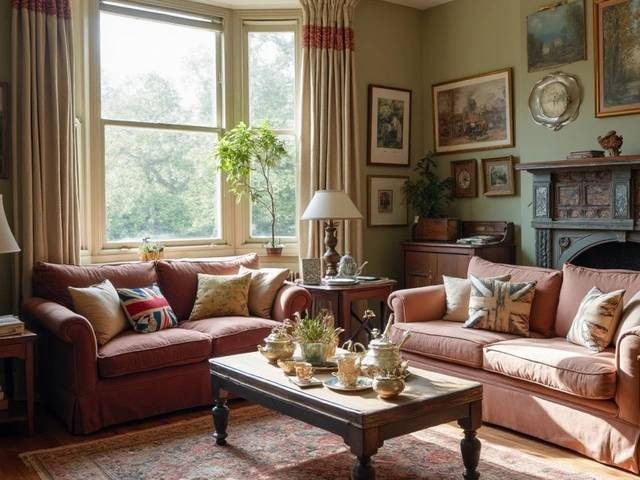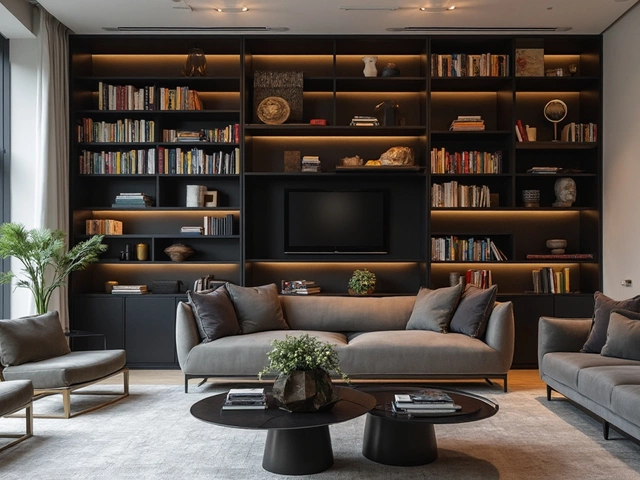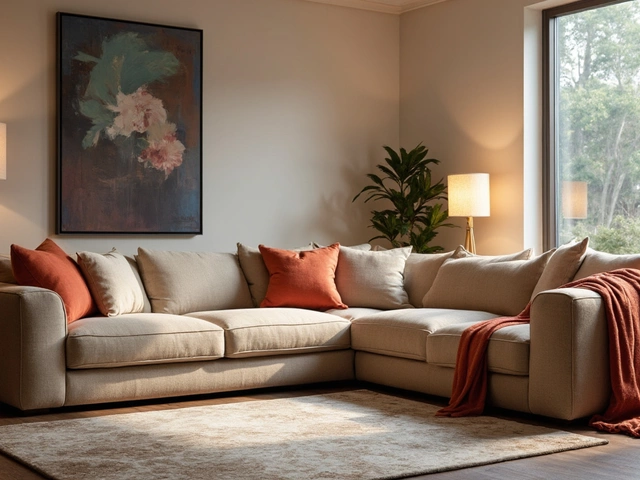When it comes to choosing a coffee table, there are often two steadfast contenders that pop up: glass and acrylic. Both offer their unique spin on contemporary elegance, yet they bring quite different attributes to the table—literally. The decision between the two can be as personal as choosing a piece of art, considering not just design, but also function and lifestyle compatibility.
Each material brings something distinct to a space. From the classic allure of glass with its airy feel and sophisticated shine to the modern versatility and resilience of acrylic, finding the right balance can transform a room. Whether you're revamping your living area or just fancy a new centerpiece, understanding the subtle nuances between glass and acrylic could enlighten your choice.
Aesthetic Appeal
When it comes to the visual allure of a coffee table, both glass coffee tables and acrylic coffee tables offer distinctively elegant appearances. A glass coffee table often embodies timeless sophistication, evoking a sense of spaciousness and lightness in any room. The transparency of glass allows for a seamless integration with different styles of decor, from minimalist to traditional. Its natural reflective qualities can add brightness to the space, giving an illusion of a larger area. Homeowners frequently appreciate the classic glass design for its ability to showcase intricate rugs or striking hardwood floors beneath, creating a captivating under-table visual that cannot be underestimated.
On the other hand, acrylic coffee tables stand out as icons of modern chic, bringing a sense of casual elegance without sacrificing durability. Their clean lines and transparent look provide a similar airy feel, much like their glass counterparts, but with a definitive edge of contemporary appeal. An acrylic table can fuse easily with a myriad of interior themes, effortlessly complementing bold patterns or vibrant colors. The versatility of acrylic also extends to unique shapes and designs, adding character and a sense of playfulness that is often harder to achieve with glass. With their translucent nature, acrylic tables are not only trendy but also a practical choice for small spaces where maintaining an open feel is desired.
Both materials impress in their own right, largely defined by the environment and style of the surrounding home. The choice between glass and acrylic can also reflect one’s personal taste, whether one leans towards the classic charm of glass or the sleek, sometimes whimsical, aura emanated by acrylic. Interestingly, a 2019 survey from the American Home Furnishings Alliance revealed that nearly 67% of respondents chose their living room furniture based on aesthetic compatibility with existing decor, which underscores the impact that these two materials can have in influencing purchasing decisions.
A well-chosen coffee table can transform your living room into a well-composed and curated space. Designers such as Jonathan Adler have noted the importance of mixing textures and styles in the home, observing that "a great table brings everything together... it anchors the room."
In a statement by famed interior designer Nate Berkus, "The right coffee table is beautiful, yet unobtrusive. It should showcase the items with which it shares space and not demand too much attention itself."This sentiment perfectly encapsulates the dual necessity of functionality and beauty both glass and acrylic coffee tables can provide, making them favored options among designers and homeowners alike. Whether you're aiming for understated elegance or a show-stealing centerpiece, the right choice between these two stunning options can elevate the overall aesthetic of your home.
Durability and Safety
When discussing durability and safety, the materials of both glass and acrylic coffee tables have their distinctive stories to tell. Glass, as we know, carries a certain delicacy about it. It can deliver a sleek and timeless look, but also demands a level of caution, especially in households brimming with playful children or enthusiastic pets. A hard knock or an accidental tumble may lead to severe damage, as glass is prone to shattering. However, tempered glass has come to the rescue of many modern-day homeowners. It's approximately four to five times stronger than standard glass and, if broken, crumbles into small, granular chunks instead of jagged shards, which significantly reduces the risk of injury.
Acrylic, on the other hand, champions itself as a formidable foe against the challenges of wear and tear. Unlike glass, it does not shatter and is less likely to chip or crack under usual household stresses. This makes it a go-to option for bustling homes where safety is a primary concern. Acrylic's lightweight nature further adds to its charm, making it easier to move and rearrange without the fear of handling a fragile item. Yet, it’s not without its own Achilles' heel. Acrylic surfaces can scratch more easily than glass, necessitating extra care to maintain their pristine clarity. A simple preventive tip? Consider using coasters and place mats to avoid scratches from daily wear.
But for lovers of numbers, here’s something to chew on: a table displaying the hardness scale of common coffee table materials.
| Material | Hardness (Mohs Scale) |
|---|---|
| Tempered Glass | ~5-6 |
| Acrylic | ~3.5 |
It’s worth noting, however, that the balance between durability and design often sees acrylic faring better in the personal safety department. A fact underscored by interior designer Marta Woodford, who once said:
"Acrylic coffee tables offer an unmatched blend of safety and style, perfect for vibrant households and chic spaces alike."This insight is invaluable when choosing a furniture piece that doesn’t just look good but also stands the test of time in daily family life.
So, as you ponder which material might suit your lifestyle and home best, don't just employ logic—remember to listen to your heart too. After all, a coffee table is more than a functional piece; it's a canvas of personal expression, where life unfolds and stories are shared.
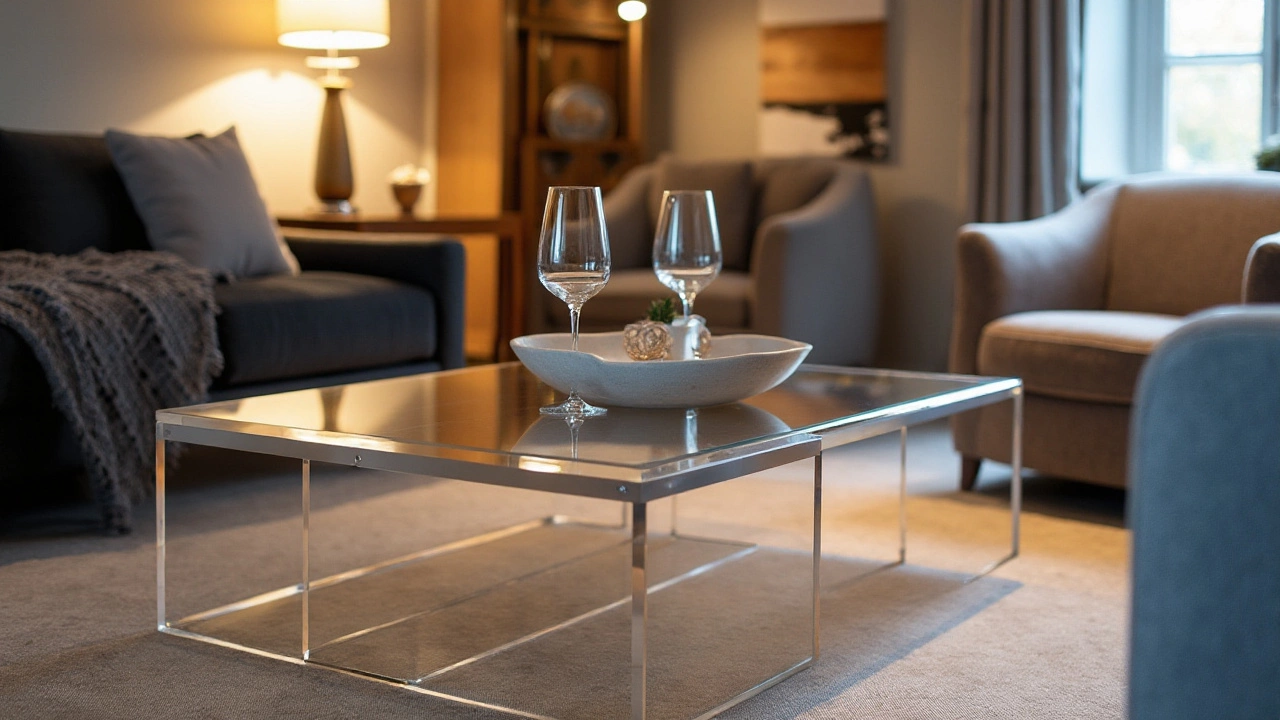
Maintenance Tips
When it comes to maintaining a glass coffee table, one key consideration is keeping it free from smudges and streaks. There's nothing like a pristine glass surface gleaming in the light, yet it notoriously picks up fingerprints and dust. Regular cleaning with a specialized glass cleaner or a simple solution of vinegar and water can keep it shining. It's crucial to use a soft cloth or microfiber to prevent scratches, which can occur with harsher materials. Make sure to wipe in circular motions to minimize streaks, ensuring that your table remains a centerpiece of clarity.
Care for an acrylic coffee table shares similarities with its glass counterpart but with an added emphasis on avoiding scratches. Acrylic is softer and more prone to nicks, so one should handle it with a little extra TLC. It's advisable to use a gentle soap and water mixture, steering clear of ammonia-based cleaners that can damage the surface. When buffing, a soft cloth works best to remove smudges without blemishing the table. An occasional polish with an acrylic-specific spray can revive its clarity and retain its elegant transparency.
"The art of living well revolves around simplicity and attention to detail, a sentiment echoed by acclaimed interior designer Darryl Carter, who says 'Design thrives in the simple, the authentic.' Maintaining your furniture with care echoes this philosophy."
For both glass and acrylic, using coasters and placemats can significantly extend the life of your table. They act as protective barriers against hot dishes or abrasive materials. In areas with heavy traffic, consider placing small felt pads under the legs or frame to protect the flooring as well as reduce the impact damage on the tables themselves. Remember, small consistent care practices go a long way in retaining the allure and functionality of your coffee tables.
If you find yourself debating between glass or acrylic based on ease of maintenance, it's worth taking into account how each fits within your day-to-day operations. For homes bustling with activity, an acrylic coffee table might be more forgiving of the occasional minor bump, while a glass option might require more vigilance but could visually enhance a quieter, more polished space.
Quick Cleaning Guide
- For glass, use a vinegar-water mix or commercial glass cleaner.
- Wipe with a circular motion using a microfiber cloth to prevent streaking.
- Acrylic needs gentle soap and water, avoiding ammonia-based solutions.
- Regular polishing enhances both materials' clarity.
- Protect surfaces with coasters and placemats to prevent scratches or heat marks.
Environmental Impact
The environmental impact of choosing between a glass coffee table and an acrylic coffee table is an often overlooked yet important consideration for the eco-conscious consumer. Glass, known for its transparency and elegance, is derived primarily from raw materials such as sand, soda ash, and limestone. The production process, although relatively straightforward, requires high heat, leading to a considerable energy consumption footprint. On the flip side, glass is highly recyclable, and when recycled, it can significantly reduce environmental burdens by lowering the need for virgin materials and diminishing energy use. Not all glass makes it back to the recycling loop, though, which presents a challenge for sustainability advocates.
Acrylic, often praised for its durability and lightweight nature, is a synthetic material derived from fossil fuels. Its production involves the polymerization of compounds like acrylonitrile and styrene, a process that tends to produce volatile organic compounds (VOCs) as by-products. These emissions can contribute to air pollution and require stringent measures to manage. Yet, acrylic stands out due to its longevity and resistance to breakage, which means less frequent replacements and potentially less waste finding its way into landfills. Unlike glass, however, acrylic is less commonly recycled, and finding appropriate facilities can be challenging.
One interesting insight into the sustainability conversation comes from the Environmental Protection Agency, which says:
“Transitioning towards materials that offer longer life spans while ensuring recyclability is paramount for sustainable design.”Glass, with its recycle and reuse potential, seems to edge out in this aspect, but only if recycling infrastructures are in place and effectively utilized. The choice between glass and acrylic affects not just waste generation and resource extraction, but also emissions related to transportation, considering their weight and distance traveled from production sites to homes. An acrylic table's light nature can offer a lower carbon footprint in transport relative to its heavier glass counterpart, an intriguing angle that often escapes the initial consideration in eco-decision making.
Despite these challenges, the positive note is the growing emphasis on sustainable production methods and the increased availability of eco-friendly alternatives. Designers opting for glass are increasingly favoring upcycled materials, while acrylic producers are experimenting with bio-based alternatives derived from renewable resources. As consumers, the responsibility lies in making informed choices and advocating for policies and products that prioritize environmental health alongside aesthetic and functional criteria.
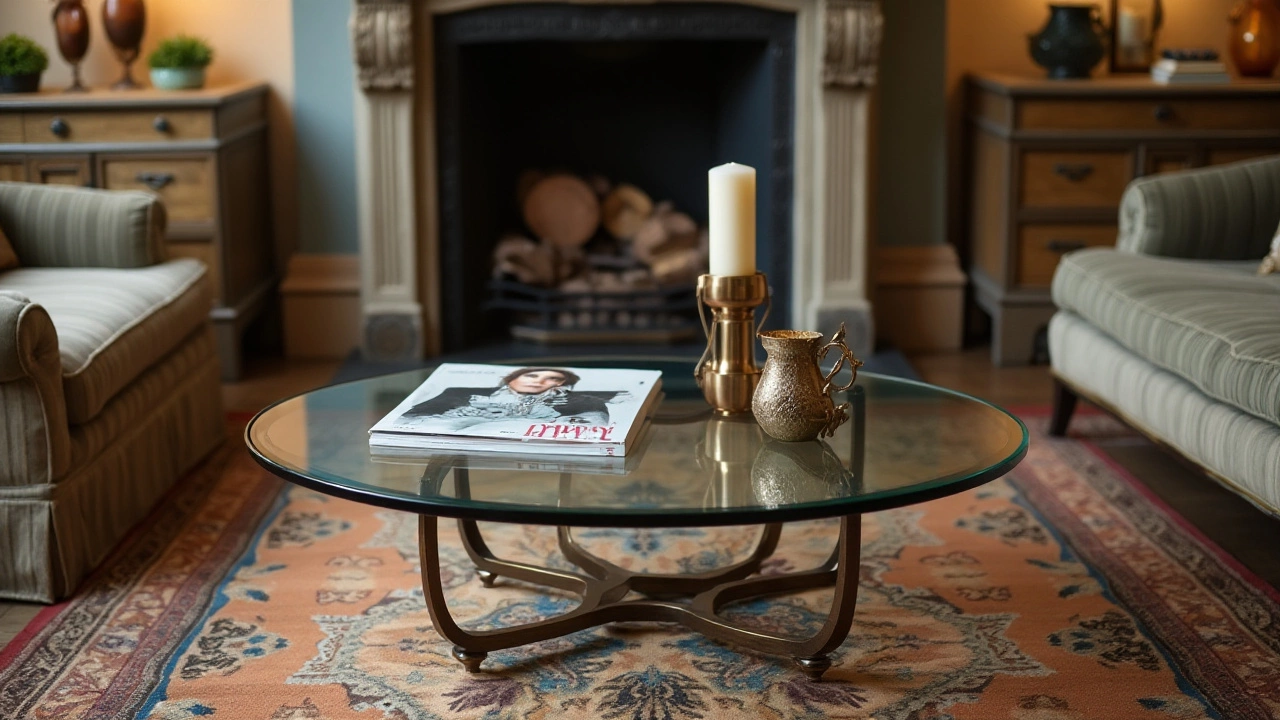
Styling Ideas
Transforming your living room's aesthetic can be as simple as selecting the right coffee table. Whether you choose a glass coffee table or one fashioned from acrylic, it's about making the piece a cohesive part of your home decor, while maintaining its unique standing as a statement piece. A key aspect of styling is understanding how these materials interact with the rest of your furnishings and decor elements. In some cases, a glass coffee table with its reflective surface might complement a room adorned with metallic accents and light color palettes, creating a bright, open atmosphere. Each ripple of light through the glass can echo the sophisticated edges of polished metal or the warmth of natural sunlight.
An acrylic coffee table, on the other hand, can carry a modern, chic vibe, often suggesting an avant-garde choice which works marvelously in spaces flaunting bolder color schemes or pattern-laden textiles. The clear nature of acrylic not only complements decor with vivid color, but it enhances the perception of space. In smaller living spaces, this characteristic becomes particularly advantageous. The unobtrusive and lightweight appearance can trick the eye into perceiving a more expansive footprint, without compromising on functionality or durability.
There are countless ways to adorn these tables to boost their appeal. For instance, try layering books with varied covers or a curated selection of design magazines for a purposeful intellectual touch or to convey a message about your interests. When accentuated with an elegant vase or antique clock, the personality of your table can shine through, telling its own story. Bringing natural elements into the mix with small plants or seasonal flowers adds freshness and offsets the sleekness with an organic feel. Don't shy away from experimenting with textiles, such as a small, intricately designed table runner or an exclusive woven coaster set, to introduce texture and warm tones.
"A cohesive and carefully styled coffee table can act as the anchor in a well-designed living room, drawing together disparate elements into a harmonious whole," remarks interior designer Maria Killam.Moreover, the placement of your coffee table is just as crucial as what sits atop it. Balance is vital—keep space enough to navigate comfortably around while allowing proximal seats or accessories to engage without seeming overcrowded. If additional light is needed, an elegant table lamp upon or nearby the table can introduce ambient lighting which can further enhance decorative displays.
Mixing Elements
If you find yourself torn between choices, consider incorporating both materials into your living space for eclectic variety. A glass coffee table with an acrylic base, for instance, merges the elegance of glass with the sturdiness of acrylic—offering a fresh, hybrid take that might surprise visitors. Pair it with a plush rug to ground the ensemble, contrasting modern lines with classic comfort. Such a look is not only inviting but speaks to a cultivated taste succeeding across contemporary design trends.
